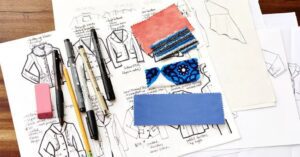Fashion design is a captivating blend of artistry, innovation, and craftsmanship. Behind every stunning garment lies a creative journey fueled by passion, vision, and meticulous attention to detail. We embark on a journey into the world of fashion design, unravelling the intricacies of the creative process and the diverse sources of inspiration that drive designers to push the boundaries of style and expression.
The Essence of Fashion Design
At its core, fashion design transforms ideas into tangible expressions of beauty and self-expression. It involves conceptualizing, sketching, and constructing garments that adorn the body, convey narratives, evoke emotions, and reflect cultural zeitgeists.
Critical Components of Fashion Design:
- Creativity: Fashion design thrives on creativity, innovation, and originality. Designers draw inspiration from diverse sources, from art and architecture to nature and technology, to infuse their creations with distinctive flair and style.
- Technical Skill: Mastery of technical skills is essential for translating design concepts into wearable garments. From pattern-making and draping to sewing and fabric manipulation, designers leverage many techniques to bring their visions to life.
- Market Awareness: Successful fashion design requires a keen understanding of market trends, consumer preferences, and industry dynamics. Designers must strike a delicate balance between artistic expression and commercial viability to resonate with their target audience.
- Collaboration: Collaboration is integral to the fashion design process, as designers often work closely with pattern-makers, sewists, and artisans to realize their creations. Effective communication and teamwork are paramount for bringing collective visions to fruition.

The Creative Process of Fashion Design
Inspiration and Conceptualization
The creative process begins with inspiration—a spark of imagination or a moment of revelation that ignites the designer’s vision. Whether inspired by a fleeting emotion, a historical era, or a cultural phenomenon, designers draw inspiration from myriad sources to develop conceptual narratives for their collections.
Sketching and Design Development
Once the initial concept is crystallized, designers translate their ideas into sketches, capturing each garment’s silhouette, details, and mood. Sketching serves as a visual roadmap, allowing designers to refine their concepts, experiment with proportions, and explore different design elements.
Fabric Selection and Material Exploration
Fabric selection plays a pivotal role in shaping a garment’s aesthetic and tactile qualities. Designers carefully evaluate various fabrics and materials, considering factors such as texture, drape, and colour to achieve their designs’ desired look and feel.
Pattern-Making and Prototyping
Pattern-making is the technical underpinning of fashion design. It entails developing templates or blueprints for cutting and assembling clothing. Designers work closely with pattern-makers to develop precise patterns that translate their design sketches into three-dimensional forms.
Fitting and Iteration
Fitting sessions are essential for refining garments’ fit, proportions, and construction. Designers collaborate with fit models to assess each design’s comfort, movement, and overall aesthetic, making adjustments and iterations as needed to achieve the desired outcome.
Finding Inspiration in Fashion Design
Nature’s Beauty and Diversity
Nature is an endless wellspring of inspiration for fashion designer, offering abundant colours, textures, and patterns to draw upon. From floral motifs to organic shapes, nature’s beauty manifests in myriad forms, inspiring designers to create garments that echo the harmony and richness of the natural world.
Art and Culture
Art and culture are perennial sources of inspiration for fashion designers, providing a rich tapestry of visual references, historical narratives, and artistic movements to explore. From Renaissance paintings to contemporary installations, art transcends boundaries and stimulates creativity, inviting designers to reinvent traditional motifs and cultural symbols innovatively.
Technology and Innovation
Technology is reshaping the landscape of fashion design, offering new tools, materials, and techniques for creative expression. From 3D printing and digital modelling to sustainable textiles and innovative fabrics, technological advancements empower designers to push traditional craftsmanship boundaries and explore new design innovation frontiers.
Conclusion
Fashion design is a dynamic and multifaceted discipline that blends artistry, craftsmanship, and innovation. From inspiration to presentation, the creative journey is one of exploration, experimentation, and expression. Fashion designers push boundaries by embracing creativity, honing skills, and drawing from diverse sources to shape tomorrow’s style.